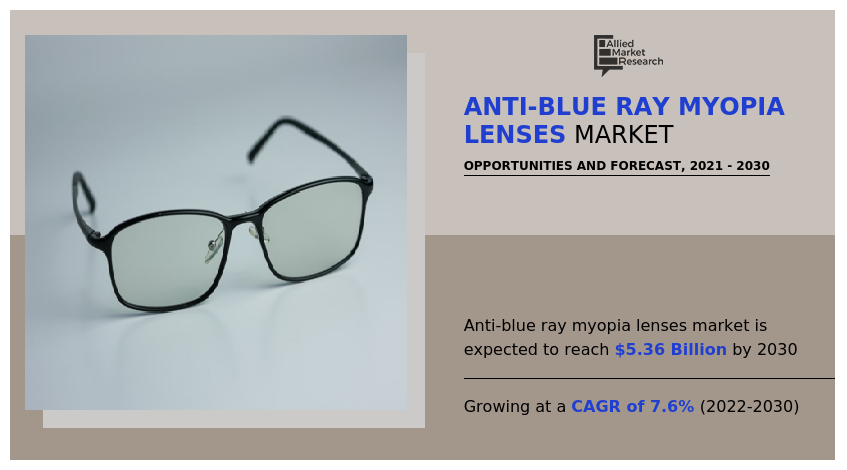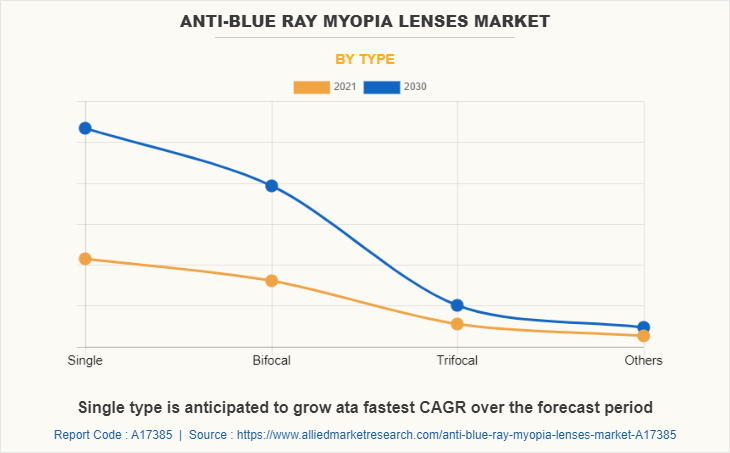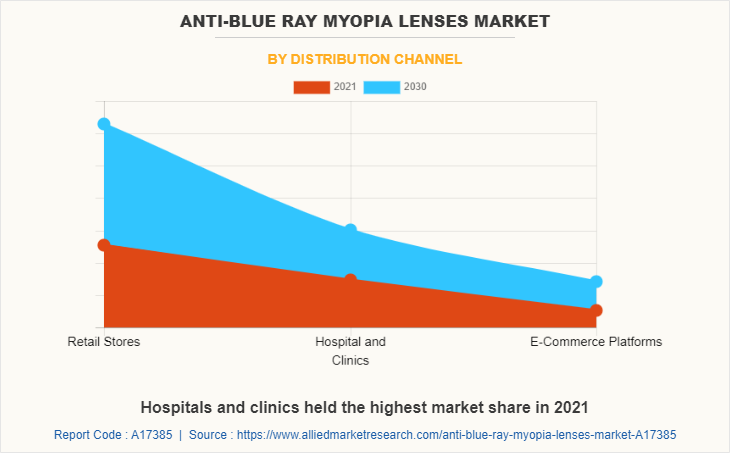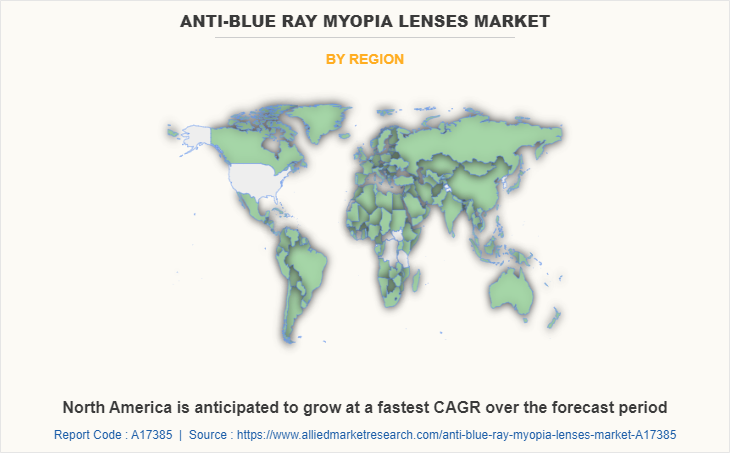Anti-Blue Ray Myopia Lenses Market Research, 2030
The global anti-blue ray myopia lenses market was valued at $2.28 billion in 2021, and is projected to reach $5.36 billion by 2030, growing at a CAGR of 7.6% from 2022 to 2030. Anti-blue ray myopia lenses are becoming more and more popular. These lenses do help to lessen eye strain and shield the eyes from dangerous blue radiation, as per analysis studies undertaken by medical professionals. Some of the benefits of using anti-blue ray myopia lenses are they decrease the possibility of migraines and macular degeneration. For instance, though a strong link between blue light and macular degeneration has not yet been conclusively proven, research suggests that macular degeneration may be more likely if blue light is exposed frequently. As a result, many specialists suggest wearing anti-blue ray myopia lenses on a daily basis to reduce the risk of developing this condition. Hence, migraines and headaches are directly related to eye strain in terms of origin and effect. Thus, using these lenses can lessen migraines' frequency and severity.

However, due to some chemicals employed in the lens production process, anti-blue ray lenses are discovered to turn yellow over time, which is a growth-restricting factor for the industry. Such key issues may create a negative impact on the Anti-Blue Ray Myopia Lenses Market forecast period.
Due to people's increasing desire to purchase high-quality items for their eye protection, the market for anti-blue ray myopia lenses is expanding extremely quickly on a global scale. According to current market trends, people all around the world want designer and fashionable spectacles. Additionally, it is anticipated that rising trends of online virtual try-ons for eyewear will accelerate the expansion of the market internationally. Customers can choose glasses from the comfort of their homes by using the virtual try-ons to suit their preferences, wants, and likes. The market for anti-blue ray myopia lenses is growing favorably as a result of rising fashion consciousness and living standards. These factors are anticipated to propel the global anti-blue ray myopia lenses market growth.
The key players profiled in this report include Essilor, HOYA GROUP, RODENSTOCK GMBH, ZEISS, Seiko, Chemiglas Corp., Nikon, Shamir Optical Industry Ltd, Mingyue Glasses Co., Ltd., and Shanghai Conant Optics Co., Ltd.
The global anti-blue ray myopia lenses market is segmented on the basis of type, distribution channel, and region. By type, the market is sub-segmented into single, bifocal, trifocal, and others. By distribution channel, the market is classified into retail stores, hospital & clinics, and e-commerce platforms. By region, the market is analyzed across North America, Europe, Asia-Pacific, and LAMEA.
The anti-blue ray myopia lenses market is segmented into Type and Distribution Channel.

By type, the single sub-segment dominated the market in 2021 and is expected to be the fastest growing sub-segment. The majority of people under the age of 40 who need to correct their nearsightedness and farsightedness use single focal lenses. Additionally, for a large portion of the population, this kind of lens is the most economical. Moreover, major industry companies are forming strategic alliances to provide customers with the greatest anti-blue ray lenses possible. These are predicted to be the major factors affecting the anti-blue ray myopia lenses market size during the forecast period.
By type, the bifocal sub-segment is expected to significantly grow during the timeframe. The use of bifocal lenses eliminates the need to switch glasses when doing two vision correction tasks. For many patients, bifocals are a practical solution because of this. A wearer can have just one pair of glasses that make it simple to do everything, rather than needing two pairs—one for driving and one for reading. These are predicted to be the major factors affecting the anti-blue ray myopia lenses market size during the forecast period.

By distribution channel, the retail stores sub-segment dominated the global anti-blue ray myopia lenses market share in 2021. This market expansion can be ascribed to an increase in the number of consumers who favor retail establishments like independent stores, wholesalers, and brand chains. This is due to the broad variety of lenses that retail stores offer, from budget-friendly to high-end brands, which is said to be one of the causes influencing customers to purchase eyewear or lenses from these establishments. Such distribution channel of anti-blue ray myopia lenses in the retail stores are bound to create a scope of growth for the sub-segment during the forecast period.

By region, Asia-Pacific market dominated the global market in 2021 and is projected to remain the fastest-growing sub-segment during the forecast period. Myopia, also known as nearsightedness and shortsightedness, is a visual anomaly wherein the resting eye concentrates the picture of a distant object at a point in front of the retina, leading to a blurred image. Myopia is becoming more common among children in Asian nations including China, India, and Japan as a result of more time spent studying or playing video games on screens while using mobile phones. Myopia has been quickly increasing among children in Southeast Asian and Eastern countries over the past 60 years as a result of educational pressure on schoolchildren, according to a review report from the NCBI (National Center for Biotechnology Information) published in May 2020. Such studies demonstrate that, in the following years, the Asia-Pacific anti-blue ray myopia lenses market will be stimulated by the exponential growth in demand for anti-blue ray myopia lenses.
Impact of COVID-19 on the Global Anti-blue Ray Myopia Lenses Industry
- COVID-19 has positively impacted anti blue ray myopia lenses industry. During the government-enforced lockdown that was put in place to stop the spread of the coronavirus sickness, most individuals spent more time on their digital screens, computers, and mobile devices. People were exposed to blue light for extended periods of time, which negatively impacted the majority of people's eye health, increasing the demand for anti-blue ray lenses.
- Increased exposure to digital screens, cell phones, and laptops as well as excessive contact with blue lights, which impair eye health, are mostly to blame for the rise in demand for anti-blue ray lenses during the pandemic.
- Due to increased screen usage during the pandemic, people have been experiencing problems including dry eyes and eye discomfort from too much exposure to blue light. Because of this, the significance of maintaining good eye health has increased dramatically, fuelling market expansion.
- ZENNI OPTICAL, an optical retail company, claimed in January 2021, that sales of blue-light filtering lenses increased up to 60% annually in comparison to the previous two years, with a sale of 2 million pairs in 2020. The aforementioned elements indicate that the pandemic may result in significant market investment opportunities in the upcoming years.
Key Benefits For Stakeholders
- This report provides a quantitative analysis of the market segments, current trends, estimations, and dynamics of the anti-blue ray myopia lenses market analysis from 2021 to 2030 to identify the prevailing anti-blue ray myopia lenses market opportunity.
- The market research is offered along with information related to key drivers, restraints, and opportunities.
- Porter's five forces analysis highlights the potency of buyers and suppliers to enable stakeholders make profit-oriented business decisions and strengthen their supplier-buyer network.
- In-depth analysis of the anti-blue ray myopia lenses market segmentation assists to determine the prevailing market opportunities.
- Major countries in each region are mapped according to their revenue contribution to the global market.
- Market player positioning facilitates benchmarking and provides a clear understanding of the present position of the market players.
- The report includes the analysis of the regional as well as global anti-blue ray myopia lenses market trends, key players, market segments, application areas, and market growth strategies.
Anti-Blue Ray Myopia Lenses Market Report Highlights
| Aspects | Details |
| By Type |
|
| By Distribution Channel |
|
| By Region |
|
| Key Market Players | essilor, rodenstock gmbh, Chemiglas Corp., seiko optical products, inc., Shanghai Conant Optics Co., Ltd., Mingyue Glasses Co., Ltd., HOYA GROUP, Shamir Optical Industry Ltd., Nikon, zeiss group |
Analyst Review
Increase in demand for anti-blue ray myopia lenses due to the shift to remote work culture which increased the usage of digital screens and mobile phones is the key factor that is projected to drive the growth of the global anti-blue ray myopia lenses market during the forecast period. In addition, the use of digital screens and mobile phones is increasing, which is primarily driving the large expansion of the anti-blue ray myopia lenses market. However, the price of anti-blue ray myopia lenses is higher than that of regular myopia lenses. During the forecast period, this factor is anticipated to impede the expansion of the global market. Future business prospects could be enormous as a result of people adopting fashion trends more frequently. Eyewear is a fashion statement these days, and many people wear them in accordance with the newest industry trends. The market for anti-blue ray myopia lenses is also anticipated to increase due to the rise in myopia among young adults and children.
Among the analyzed regions, Asia-Pacific is expected to account for the highest revenue in the market by the end of 2030, followed by Europe, North America, and LAMEA. Growing fashion trends for anti-blue ray myopia lenses in the market is the key factor responsible for leading position of North America and Asia-Pacific in the global anti-blue ray myopia lenses market.
Strategic alliances among market players, along with growing eye disease is expected to accelerate the growth of the anti-blue ray myopia lenses market is the major market driver. In addition, the increasing adoption of fashion trends may create huge opportunities for the market in the future. Now-a-days, eyewear is a fashion statement, and many people are using them according to the latest market trends, which is estimated to generate excellent opportunities in the anti-blue ray myopia lenses market.
Retail stores sub-segment of the distribution channel acquired the maximum share of the global anti-blue ray myopia market in 2021.
The use of anti-blue ray myopia lenses as single, bifocal, trifocal, others is estimated to drive the adoption of anti-blue ray myopia lenses.
North America will provide more business opportunities for the global anti-blue ray myopia lenses market in future.
Essilor, HOYA GROUP, RODENSTOCK GMBH, ZEISS, Seiko, Chemiglas Corp., Nikon, Shamir Optical Industry Ltd, Mingyue Glasses Co., Ltd., and Shanghai Conant Optics Co., Ltd. are the major players in the anti-blue ray myopia lenses market.
The major growth strategies adopted by anti-blue ray myopia lenses market players are investment and agreement.
The report provides an extensive qualitative and quantitative analysis of the current trends and future estimations of the global anti-blue ray myopia lenses market from 2021 to 2030 to determine the prevailing opportunities.
Loading Table Of Content...



